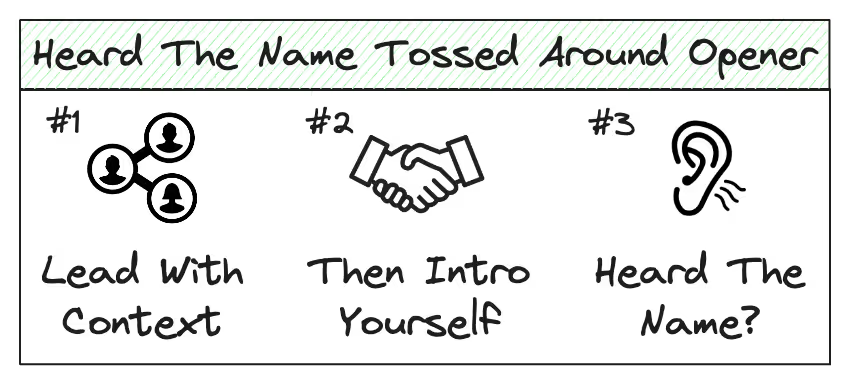Hey folks! This is an abridged excerpt from The Book on Cold Calling as a special sneak peek for our wonderful subscribers. Enjoy :)
***
I sold life insurance back in college and got absolutely eviscerated in my first 4 weeks on the phone: 800 dials, 0 meetings booked in 4 weeks.
I was cold calling partners of law firms and they could smell the youthful telemarketer in me. Until one day, a top producer named Brandon Hoffman came by my desk and told me to use this funky opener that looked like this:

I was massively skeptical. The line felt like a cringey flex, even borderline unethical. But he was right, I had nothing to lose.
I called a law firm partner named Bill and dropped the opener. Bill replied:
“Well, no I haven’t. But, how can I help you?”
(Oh friendly now, aren’t we Bill?)
I didn’t know what was supposed to come next and I’d barely made it this far in the past. So I followed up with my mediocre but brief pitch: a one-sentence summary of how we help other law firm partners invest while saving on taxes.
I kid you not. 2 minutes later, Bill booked the meeting.
I couldn’t believe it. Same law firm. Same pitch. Same 19 year old kid without confidence. Only one freaking thing changed: the way that I opened the cold call.
It had to be a fluke. I kept going.
“Heard the name tossed around?” 2 meetings booked.
“Heard the name tossed around?” 3 meetings booked.
40 dials in, I literally booked 3 meetings in a single session alone. More meetings in 1 hour than I had in the entire last 4 weeks of cold calling combined.
The entire demeanor of the cold call was changed by leading with context that established me as a peer instead of introducing myself and asking “how’s your day going?” or “did I catch you at a bad time?” like a telemarketer.
So let's breakdown why it works and how you can adapt it to your own style.
Breakdown: "The Heard The Name Tossed Around" Cold Call Opener

There are 3 steps to the opener as pictured above.
Step 1: Lead with context before you say anything else, even your name.
“Hey Bill, we work with a few other partners in the Skadden LA office."
We want to establish ourselves as a peer and have them forget that it's a cold call by leading with the fact that we work with other people like them.
The first words that come out of your mouth determine whether or not the prospect listens to anything else you say, which means you don't introduce yourself, ask how their day is going, or ask if now's a bad time because that's exactly what a telemarketer would do.
Instead, lead with a common thread between you and them. For me, it was the fact that we worked with other partners in their office. But I've worked at companies from 9 employees to 200,000 employees and found that all of these variations that work well:
- Same Investor: We work with a few other Sequoia portfolio companies.
- Same Coworkers: We work with a few other Partners in the Downtown LA office.
- Same Situation: We work with a few other multifamily homeowners down the block.
- Same Industry Peers: We work with a few folks like Gong and Salesforce.
- Same Geo + Persona: We work with other compensation leaders in Salt Lake City.
The more specific you can get, the better. You’ll notice the last one was a combination between geography and persona to make it feel close to home. But opening with “we work with other professionals who breathe” isn’t particularly compelling.
Step 2: Introduce yourself after the context
“It’s Armand from Northwestern"
Again, it's critical that this comes after the context.
If you lead with your name and company, they'll immediately categorize you as a telemarketer instead of a peer.
Step 3: Ask the question
"Heard the name tossed around?”
The final question is the twist at the end of the punch. You already got Bill to sit up by telling him that you work with his peers, and now we’re going to lean into it even more.
We want him thinking: I haven’t heard of them… but should I have?
From here, they’ll either answer "yes" or "no" -- which brings you to 1 of 2 transitions off this cold call opener.
Transitions after “Heard The Name Tossed Around?”
-1.avif)
Transitions off the "Heard The Name Tossed Around" Opener
The vast majority of people will say “no” so let’s start there.
It does not matter if they’ve heard your name tossed around. It’s about making it seem like they should have. If you come off as startled or suddenly stiff, you have revealed your rando mask.
Instead, joke as if they should have heard your name tossed around, like this:
“Ha! Guess I’m not as popular as I thought. Well, the reason for my call is…” and from there I go into a very short pitch.
But if someone says "yes" -- you don’t need to pitch. You want to figure out if they had any objections in working with you from the past (instead of regurgitating the pitch they already heard):
“Oh good, we’d normally be working with someone like you by now. What’d you hear?”
If they give you an objection, now you know where to start (and we'll cover how to handle objections in a later chapter.
But usually, they still have no clue what you do. So you end up giving them the pitch, but it lands much better because you're giving it through the lens of how you help their peers.
Now, you can say all the right words... but if you sound unsure or overly stiff like a telemarketer this opener is going to fall flat. Let's finish with tone.
Tone: Put your feet up on the desk (Scan the QR)

How I actually sat when recording this one – lean back, feet up
Imagine you’re leaning back in the chair with your feet up on the desk. You should sound assumptive, as if you’re expecting them to know you. Imagine you’re calling a referral (Hey Jane, we both know Nick. He gave you a heads up that I’d be calling, right?).
The two most common tone mistakes here are over-enunciation and upward inflection.
- Over-enunciation makes you sound like you’re reading off a billboard (Welcome to this cold call, we work with a number of partners in the law firm!).
- Upward inflection makes you sound unsure (We work with a few other partners in the office? it’s Armand… at Northwestern Mutual?).
Have a buddy record you having a normal conversation when you’re not expecting it. Listen to that tape – that’s exactly how you should sound on a cold call.
Chances are, you speak much more casually and you end your sentences on a down-tone because you’re confident in what you’re saying.
This is much easier heard than written, so scan the QR codes below for 2 examples: a stiff (bad) one and a "feet-up" (good) one:

***
We're getting really, really, really close to being done with the book folks and it's slated to drop in August.
If you liked this, you can check out the book here:



.avif)













